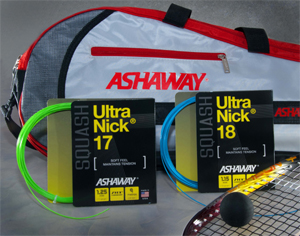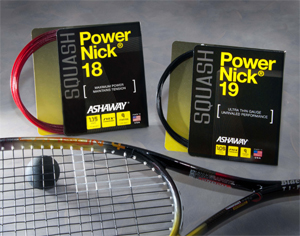|
|

Comparing Zyex®, Gut and Nylon
By Steve Crandall
Vice President, Sales & Marketing
Ashaway Racket Strings
One of the difficulties in talking about string is that we have no common frame of reference. When someone says its 25°F outside, you know you should probably wear a coat. Conversely, if someone says they "fried" themselves at the beach, or "overindulged" at dinner, you also have a fairly accurate idea of what they mean. But when we talk about racquet string, we not only have no convenient numerical standards, like temperature, but even qualitative descriptors like "durability" and "playability" mean different things to different people.
 |
 |
| The dynamic stiffness of Zyex is the closest to gut of any synthetic string material. It has even been called the "space age nylon." This means it absorbs and returns impact force more like gut - with our UltraNick® string, we call this "soft power." It controls the ball more like gut, especially in thinner gauge strings, and holds tension as well, or perhaps even a bit better than gut. PowerNick®, on the other hand, uses a different Zyex construction to provide "hard power." |
Crawford Lindsey, Rob Cross, and company at USRSA (RacquetTECH.com) have been doing some very interesting studies to measure string performance which, one day, may well result in a standardized rating scheme for all strings. But for now, their work is highly technical and has yet to reach the common vernacular. For example, if I told you that gut had a dynamic stiffness of 108 lb./in, Zyex® around 145 lb./in, and nylon between 161 and 225 lb./in, it probably wouldn't mean much.
This lack of common reference can be especially difficult when we're not just talking about a specific string, but a string material—like Zyex, which has gotten a lot of attention lately—or even a method of constructing string that can be applied to a whole range of string products.
One way to get around this difficulty is to compare a new string or material with another string or material whose characteristics are more well known. In tennis, the universal "gold standard" for comparison has always been gut. For squash, the more universally understood material is probably nylon (which, by the way, Ashaway has been using to make strings since 1949). Let's take a look at these two materials and see how Zyex matches up.
Natural gut has a number of properties that make it ideal for racquet strings. Made from the intestines of cows (not cats!), its performance has been unmatched since it was first introduced in the nineteenth century. What makes gut a superstar is its ability to stretch on impact and then rebound quickly without deformation or loss of tension. That's why the low dynamic stiffness number mentioned above. This means several things: 1) the string absorbs the force of impact, not the racquet or the player's arm. In other words, gut plays "soft;" 2) it returns that force to the ball very quickly and efficiently, providing more power; 3) because it stretches, it allows the ball more dwell time on the strings. This lets you "pocket" the ball and enhances control; 4) gut maintains tension over the life of the string, enhancing its value. Gut is also quite durable when struck on the sweet spot, but not so much on off-hits, making it better for better players. On the downside, gut is very expensive and, without protective coatings, is very sensitive to moisture: it sags.
Nylon has been the most gut-like alternative to gut for many years, and has long been the gold standard for squash. Most current nylon strings are multifilaments: many thin strands of nylon, bundled in a protective jacket. Nylon strings are very inexpensive compared to other synthetics; are very responsive; not sensitive to moisture (or other chemicals, for that matter); and provide good abrasion resistance. In terms of USRSA's dynamic stiffness rating, nylon is quite respectably low, especially when compared with aramid strings that top the stiffness scale at 500 to 886 lb./in. Nylon's main drawback is that it loses tension more quickly than other string materials. This means it doesn't last as long in your racquet, so while it's less expensive, you have to buy more of it.
By comparison, the dynamic stiffness of Zyex is the closest to gut of any synthetic string material. It has even been called the "space age nylon." (In fact, Zyex is very much a space age material. See our earlier column, "What in the World is Zyex, Anyway?". This means it absorbs and returns impact force more like gut—with our UltraNick® string, we call this "soft power." It controls the ball more like gut, especially in thinner gauge strings, and holds tension as well, or perhaps even a bit better than gut. Zyex is impervious to moisture and offers excellent abrasion resistance to enhance durability. And, of course, it's cheaper than gut.
Better still, Zyex offers more variety. Unlike gut and nylon, which are primarily multifilament constructions, Zyex can be constructed as a multifilament (UltraNick); a multistranded monofilament (Ashaway PowerNick®); or, for tennis, as a straight monofilament. This, along with a broader range of gauges than either nylon or gut, allows players to more closely tailor their string choice to their style of play. Next time, we'll look at these construction methods and how they affect string performance.
This article previously appeared in Squash Magazine.
|

